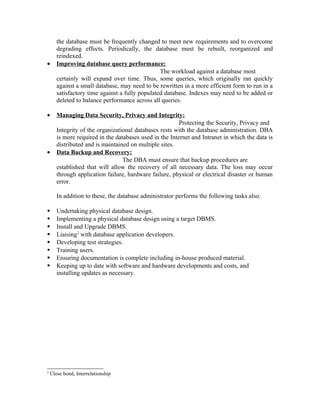1.data base administrator
- 1. Database Administration: The management of the physical realization of a database application which includes physical database design and implementation, setting security and integrity controls, monitoring system performance and reorganizing the database if necessary. A DBMS is a complex software package. Installing, running and upgrading a DBMS are not trivial1 tasks. Even with personal computer-based systems, these tasks can require the services of a database administrator (DBA). The DBA position is generally staffed by a specialist who is trained in the administration of a particular DBMS. In smaller companies instead of hiring a specialist, one of the lead developers may be asked to perform DBA duties. DBA Tasks: • Enforces standards, policies and procedures: Every database application requires protection established through consistent enforcement of data policies, procedures and standards. Data Policies are statements that make explicit the goals of data administration. For example “Every user must have a password.” Data Procedures are written outlines of actions to be taken in order to perform a certain activity. For example, Backup and Recovery procedures should be communicated to all involved employees. Data Standards are explicit conventions and behaviors that are to be followed and that can be used to help evaluate database quality. For example naming conventions for database objects should be standardized for programmers. • Planning: A key administration function is involvement with the development of the organization’s information architecture. Effective administration requires both the understanding of the needs of the organization for information and ability to contribute to the development of an information architecture that will meet the diverse needs of the typical organization. • Data Conflict Resolution: Databases are intended to be shared and usually involve data from several different departments of the organization. Ownership of data is a ticklish issue at least occasionally in every organization. Database administrators are well placed to resolve data ownership issues because they are not typically associated with a certain department. Establishing procedures for resolving such conflicts is essential. If the database administration is given a sufficient authority to mediate and enforce the resolution of the conflict, they may be very effective in this capacity. • Monitor and tune the database performance: Because databases are dynamic, it is impossible that the initial design of the database will be sufficient to achieve the best processing performance for the life of the database. The performance of the database (query and update processing time) needs to be constantly monitored. The design of 1 Not Important
- 2. the database must be frequently changed to meet new requirements and to overcome degrading effects. Periodically, the database must be rebuilt, reorganized and reindexed. • Improving database query performance: The workload against a database most certainly will expand over time. Thus, some queries, which originally ran quickly against a small database, may need to be rewritten in a more efficient form to run in a satisfactory time against a fully populated database. Indexes may need to be added or deleted to balance performance across all queries. • Managing Data Security, Privacy and Integrity: Protecting the Security, Privacy and Integrity of the organizational databases rests with the database administration. DBA is more required in the databases used in the Internet and Intranet in which the data is distributed and is maintained on multiple sites. • Data Backup and Recovery: The DBA must ensure that backup procedures are established that will allow the recovery of all necessary data. The loss may occur through application failure, hardware failure, physical or electrical disaster or human error. In addition to these, the database administrator performs the following tasks also.  Undertaking physical database design.  Implementing a physical database design using a target DBMS.  Install and Upgrade DBMS.  Liaising2 with database application developers.  Developing test strategies.  Training users.  Ensuring documentation is complete including in-house produced material.  Keeping up to date with software and hardware developments and costs, and installing updates as necessary. 2 Close bond, Interrelationship


